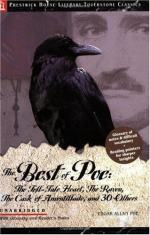Through the industry of Poe’s successive biographers, the hit made by The Raven has become an oft-told tale. The poet’s young wife, Virginia, was fading before his eyes, but lingered for another year within death’s shadow. The long, low chamber in the house near the Bloomingdale Road is as famous as the room where Rouget de l’Isle composed the Marseillaise. All have heard that the poem, signed “Quarles,” appeared in the “American Review,” with a pseudo-editorial comment on its form; that Poe received ten dollars for it; that Willis, the kindest and least envious of fashionable arbiters, reprinted it with a eulogy that instantly made it town-talk. All doubt of its authorship was dispelled when Poe recited it himself at a literary gathering, and for a time he was the most marked of American authors. The hit stimulated and encouraged him. Like another and prouder satirist, he too found “something of summer” even “in the hum of insects.” Sorrowfully enough, but three years elapsed,—a period of influence, pride, anguish, yet always of imaginative or critical labor,—before the final defeat, before the curtain dropped on a life that for him was in truth a tragedy, and he yielded to “the Conqueror Worm.”
“The American Review: A Whig Journal” was a creditable magazine for the time, double-columned, printed on good paper with clear type, and illustrated by mezzotint portraits. Amid much matter below the present standard, it contained some that any editor would be glad to receive. The initial volume, for 1845, has articles by Horace Greeley, Donald Mitchell, Walter Whitman, Marsh, Tuckerman, and Whipple. Ralph Hoyt’s quaint poem, “Old,” appeared in this volume. And here are three lyrics by Poe: “The City in the Sea,” “The Valley of Unrest,” and The Raven. Two of these were built up,—such was his way,—from earlier studies, but the last-named came out as if freshly composed, and almost as we have it now. The statement that it was not afterward revised is erroneous. Eleven trifling changes from the magazine-text appear in The Raven and Other Poems, 1845, a book which the poet shortly felt encouraged to offer the public. These are mostly changes of punctuation, or of single words, the latter kind made to heighten the effect of alliteration. In Mr. Lang’s pretty edition of Poe’s verse, brought out in the “Parchment Library,” he has shown the instinct of a scholar, and has done wisely, in going back to the text in the volume just mentioned, as given in the London issue of 1846. The “standard” Griswold collection of the poet’s works abounds with errors. These have been repeated by later editors, who also have made errors of their own. But the text of The Raven, owing to the requests made to the author for manuscript copies, was still farther revised by him; in fact, he printed it in Richmond, just before his death, with the poetic substitution of “seraphim whose foot-falls” for “angels whose faint




